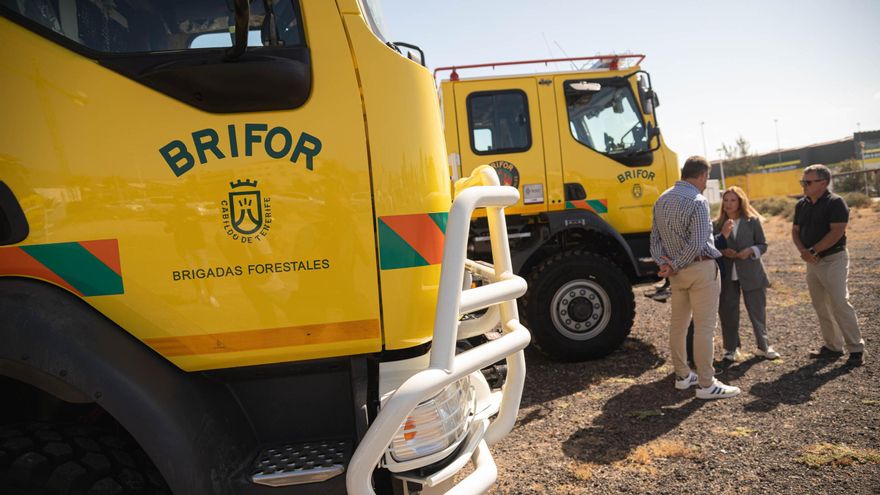
Four heavy forest fire engines 4×4 have been added to the vehicle fleet of the Forest Brigades (Brifor) of the Cabildo of Tenerife to fight fires “quickly and directly” in the mountains. The guarantee is to have 12,000 litres, 3,500 per truck, for the first attack on the fire, in just ten minutes. This is a key tool in the initial phase of the incident.
These are state-of-the-art designs, costing 300,000 euros each, and bringing the total to 19 units specifically for fire fighting. They are also designed to operate in rugged and hard-to-access areas, as well as in extreme conditions. The island president, Rosa Dávila, and the councillor for Natural Resources, Sustainability and Safety, and Emergencies, Blanca Pérez, presented the new fire engines added at the Brifor headquarters in the Industrial Park of Valle de Güímar. Also present were, among others, the island directors, Iván Martín (Safety and Emergencies) and Pedro Millán (Environment), as well as forest technician José María Sánchez.
Logistical Muscle
Politicians and technicians explain that, in addition to these resources, the prevention and extinction operation deployed since the 2nd of July forms the largest logistical and technological muscle of the Cabildo of Tenerife. It includes support vehicles, off-road vehicles, drones, helicopters, and an advanced command post, among other key resources to prevent and combat potential forest fires on the island.
Anywhere
“These fire engines enhance our intervention capacity and make a difference in the way we respond to fires,” said Rosa Dávila. “They are vehicles that can reach areas that were previously inaccessible and operate with great efficiency, supported by an increasingly autonomous and modern operation,” she added. Blanca Pérez reminded everyone that “this operation is the result of much work and planning in advance while listening to the teams on the ground. What we are presenting today is just part of everything we have been adding to be better prepared to act quickly and effectively when needed.”
Fourteen Fire Engines
In the period 2023-2025, the Cabildo of Tenerife has incorporated 14 heavy forest fire engines into the operation, along with 3 medium Unimog fire engines and 2 support vehicles with a capacity of 9,000 litres to supply water to other vehicles, representing an investment of around 6 million euros.
Aerial Resources
In terms of aerial resources, Tenerife has two helicopters operational year-round, based in the south of the island, which have a capacity of 1,000 litres and geopositioning technology. Additionally, there are multi-purpose BRIF helicopters from the Government of the Canary Islands, the Air Tractor aircraft based in La Gomera, and specialised drones. Furthermore, this year, military helicopters equipped with night vision are also available to enhance surveillance during the night.
Drones
In the field of unmanned aerial vehicles, the Cabildo of Tenerife has added three drones equipped with thermal and visual cameras that allow for precise real-time surveillance, even in low visibility conditions. In this regard, Blanca Pérez points out that “these devices have become a key tool for detecting fire outbreaks in their early stages, analysing the development of active hotspots, and coordinating the response from the air, thereby enhancing operational capacity in difficult-to-access areas.”
Agility and Safety
Rosa Dávila asserts that “this set of resources, both new and those added in previous years, enables us to respond with agility and safety to a fire.”
Human Deployment
The operational deployment extends from July 2nd to November 2nd, the period of highest risk. The Cabildo reminds that over 900 personnel are part of this island-wide device: the Forest Brigades (Brifor), reinforcements from Gesplan, Guardia Civil, Army, Civil Protection, the Consortium of Firefighters, Red Cross, UME, and the Teide National Park.
Operation Prometheus
One of the key reinforcements this year is the second edition of Operation Prometheus, in collaboration with the Army, which foresees the deployment of 920 military patrols for deterrent surveillance. Notably, the operation includes night flights thanks to helicopters from the VI Maneuver Battalion based in Los Rodeos.
Training
The campaign also includes continuous training in extinguishing techniques, fire behaviour, and action in interface fires. Additionally, extraordinary measures will be activated in the event of extreme risk episodes, such as the prohibition of agricultural burns, fireworks, or the preventive closing of forest tracks. This means that the alert operation will be similar to that which would be deployed in the event of a fire in the island’s forests.
Subscribe to continue reading
















